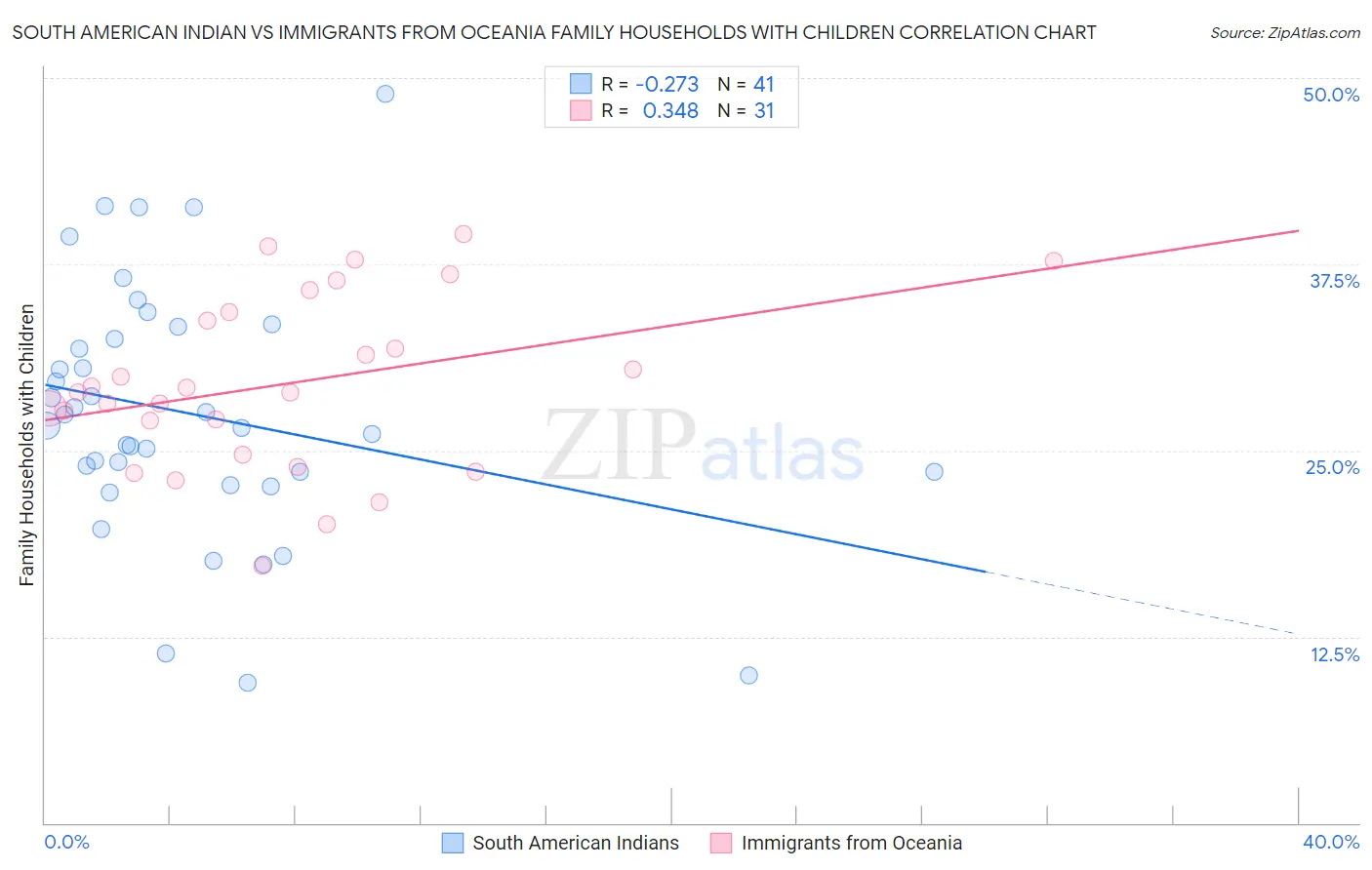South American Indian vs Immigrants from Oceania Family Households with Children
COMPARE
South American Indian
Immigrants from Oceania
Family Households with Children
Family Households with Children Comparison
South American Indians
Immigrants from Oceania
28.0%
FAMILY HOUSEHOLDS WITH CHILDREN
96.9/ 100
METRIC RATING
114th/ 347
METRIC RANK
28.1%
FAMILY HOUSEHOLDS WITH CHILDREN
98.8/ 100
METRIC RATING
101st/ 347
METRIC RANK
South American Indian vs Immigrants from Oceania Family Households with Children Correlation Chart
The statistical analysis conducted on geographies consisting of 164,526,695 people shows a weak negative correlation between the proportion of South American Indians and percentage of family households with children in the United States with a correlation coefficient (R) of -0.273 and weighted average of 28.0%. Similarly, the statistical analysis conducted on geographies consisting of 305,304,848 people shows a mild positive correlation between the proportion of Immigrants from Oceania and percentage of family households with children in the United States with a correlation coefficient (R) of 0.348 and weighted average of 28.1%, a difference of 0.52%.

Family Households with Children Correlation Summary
| Measurement | South American Indian | Immigrants from Oceania |
| Minimum | 9.4% | 17.3% |
| Maximum | 48.9% | 39.5% |
| Range | 39.5% | 22.2% |
| Mean | 27.5% | 29.5% |
| Median | 26.7% | 28.9% |
| Interquartile 25% (IQ1) | 23.1% | 24.7% |
| Interquartile 75% (IQ3) | 32.9% | 34.3% |
| Interquartile Range (IQR) | 9.8% | 9.6% |
| Standard Deviation (Sample) | 8.5% | 5.8% |
| Standard Deviation (Population) | 8.4% | 5.7% |
Demographics Similar to South American Indians and Immigrants from Oceania by Family Households with Children
In terms of family households with children, the demographic groups most similar to South American Indians are Immigrants from Africa (28.0%, a difference of 0.010%), Arab (28.0%, a difference of 0.020%), Immigrants from Middle Africa (28.0%, a difference of 0.030%), Scandinavian (28.0%, a difference of 0.050%), and Spaniard (28.0%, a difference of 0.12%). Similarly, the demographic groups most similar to Immigrants from Oceania are Immigrants from the Azores (28.1%, a difference of 0.020%), Indonesian (28.1%, a difference of 0.020%), Immigrants from Kenya (28.1%, a difference of 0.030%), Assyrian/Chaldean/Syriac (28.1%, a difference of 0.030%), and Chilean (28.1%, a difference of 0.080%).
| Demographics | Rating | Rank | Family Households with Children |
| Chileans | 98.9 /100 | #97 | Exceptional 28.1% |
| Immigrants | Kenya | 98.9 /100 | #98 | Exceptional 28.1% |
| Immigrants | Azores | 98.8 /100 | #99 | Exceptional 28.1% |
| Indonesians | 98.8 /100 | #100 | Exceptional 28.1% |
| Immigrants | Oceania | 98.8 /100 | #101 | Exceptional 28.1% |
| Assyrians/Chaldeans/Syriacs | 98.7 /100 | #102 | Exceptional 28.1% |
| Palestinians | 98.5 /100 | #103 | Exceptional 28.1% |
| Sioux | 98.3 /100 | #104 | Exceptional 28.1% |
| Choctaw | 98.3 /100 | #105 | Exceptional 28.1% |
| Immigrants | South America | 98.0 /100 | #106 | Exceptional 28.0% |
| Immigrants | Uganda | 97.7 /100 | #107 | Exceptional 28.0% |
| Immigrants | Burma/Myanmar | 97.7 /100 | #108 | Exceptional 28.0% |
| Tohono O'odham | 97.6 /100 | #109 | Exceptional 28.0% |
| Spaniards | 97.4 /100 | #110 | Exceptional 28.0% |
| Scandinavians | 97.1 /100 | #111 | Exceptional 28.0% |
| Immigrants | Middle Africa | 97.0 /100 | #112 | Exceptional 28.0% |
| Arabs | 97.0 /100 | #113 | Exceptional 28.0% |
| South American Indians | 96.9 /100 | #114 | Exceptional 28.0% |
| Immigrants | Africa | 96.8 /100 | #115 | Exceptional 28.0% |
| Pakistanis | 96.0 /100 | #116 | Exceptional 27.9% |
| Immigrants | Malaysia | 95.9 /100 | #117 | Exceptional 27.9% |